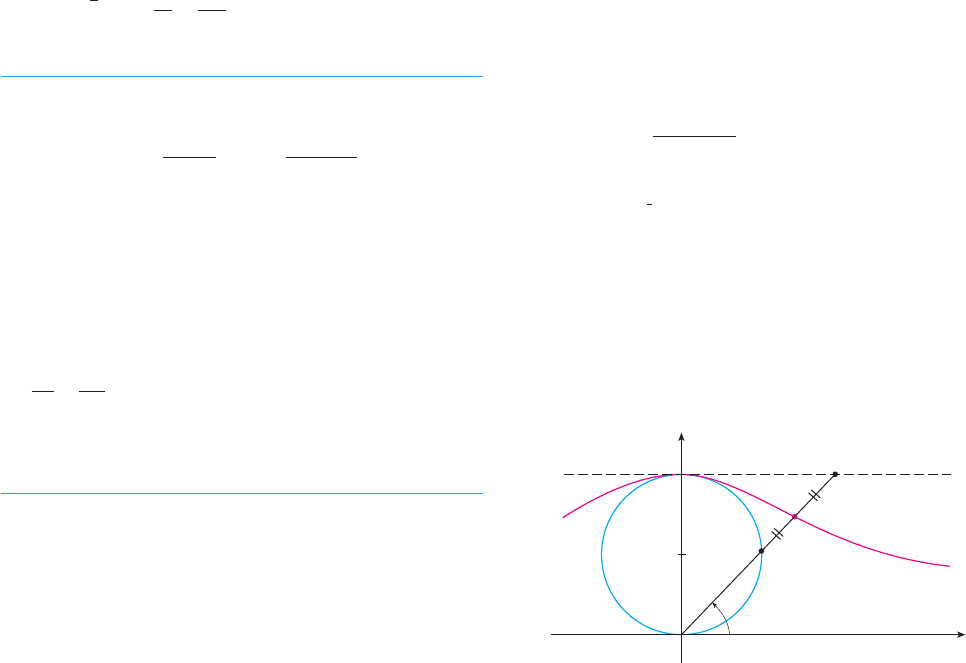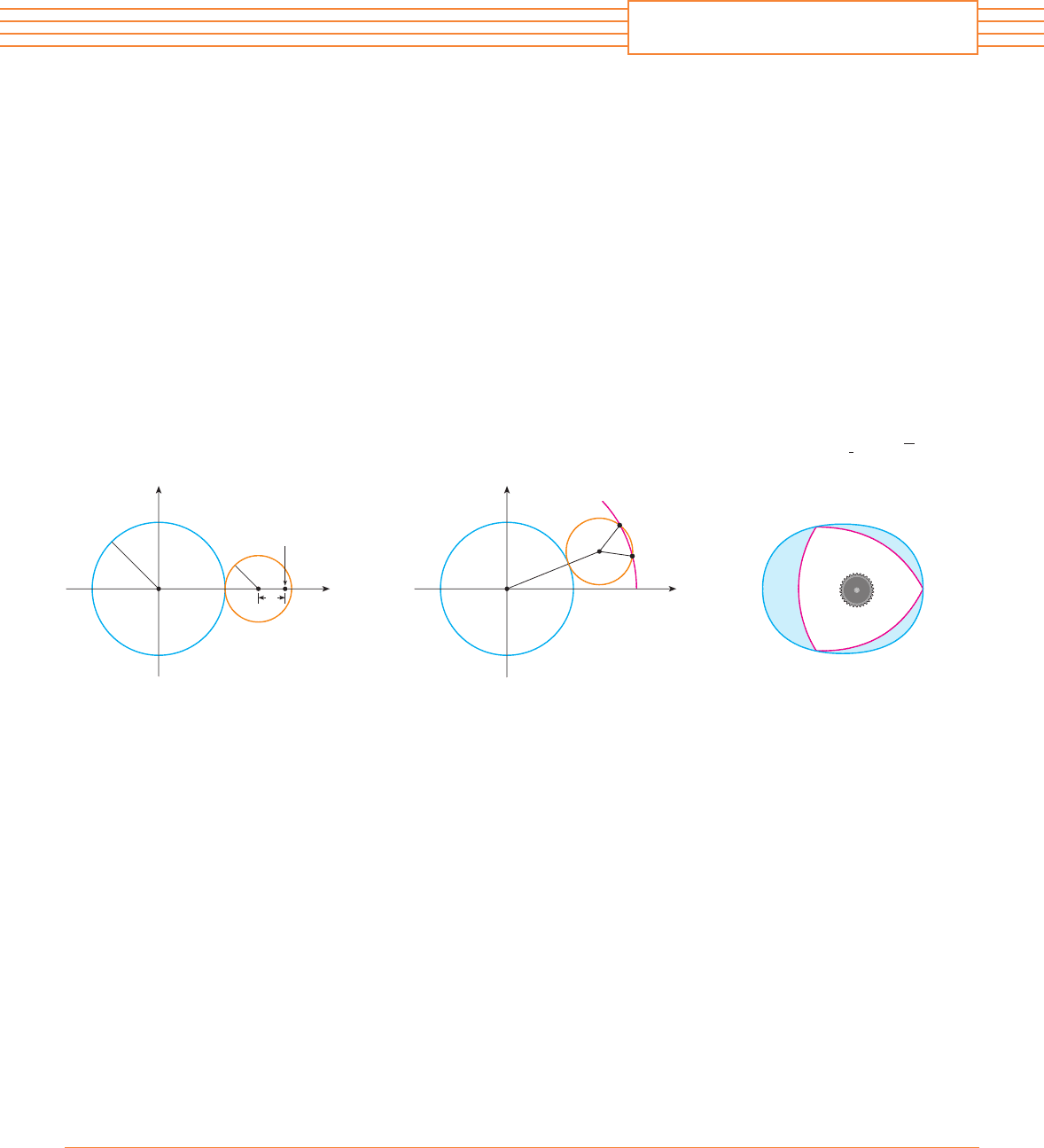Stewart J. Calculus
Подождите немного. Документ загружается.


In Figure 6 we use a computer to sketch a number of conics to demonstrate the effect
of varying the eccentricity . Notice that when is close to 0 the ellipse is nearly circular,
whereas it becomes more elongated as . When , of course, the conic is a
parabola.
KEPLER’S LAWS
In 1609 the German mathematician and astronomer Johannes Kepler, on the basis of huge
amounts of astronomical data, published the following three laws of planetary motion.
KEPLER’S LAWS
1.
A planet revolves around the sun in an elliptical orbit with the sun at one focus.
2. The line joining the sun to a planet sweeps out equal areas in equal times.
3. The square of the period of revolution of a planet is proportional to the cube of
the length of the major axis of its orbit.
Although Kepler formulated his laws in terms of the motion of planets around the sun,
they apply equally well to the motion of moons, comets, satellites, and other bodies that
orbit subject to a single gravitational force. In Section 14.4 we will show how to deduce
Kepler’s Laws from Newton’s Laws. Here we use Kepler’s First Law, together with the
polar equation of an ellipse, to calculate quantities of interest in astronomy.
For purposes of astronomical calculations, it’s useful to express the equation of an
ellipse in terms of its eccentricity and its semimajor axis . We can write the distance
from the focus to the directrix in terms of if we use (4):
So . If the directrix is , then the polar equation is
r !
ed
1 ! e cos
*
!
a!1 " e
2
"
1 ! e cos
*
x ! ded ! a!1 " e
2
"
a
2
!
e
2
d
2
!1 " e
2
"
2
? d
2
!
a
2
!1 " e
2
"
2
e
2
? d !
a!1 " e
2
"
e
a
dae
F I G U R E 6
e=1 e=1.1 e=1.4 e=4
e=0.96e=0.86e=0.68e=0.1 e=0.5
e ! 1e l 1
"
ee
702
|| ||
CHAPTER 11 PARAMETRIC EQUATIONS AND POLAR COORDINATES

SECTION 11.6 CONIC SECTIONS IN POLAR COORDINATES
|| ||
703
The polar equation of an ellipse with focus at the origin, semimajor axis ,
eccentricity , and directrix can be written in the form
The positions of a planet that are closest to and farthest from the sun are called its peri-
helion and aphelion, respectively, and correspond to the vertices of the ellipse. (See
Figure 7.) The distances from the sun to the perihelion and aphelion are called the peri-
helion distance and aphelion distance, respectively. In Figure 1 the sun is at the focus ,
so at perihelion we have and, from Equation 7,
Similarly, at aphelion and .
The perihelion distance from a planet to the sun is and the aphelion
distance is .
EXAMPLE 5
(a) Find an approximate polar equation for the elliptical orbit of the earth around the sun
(at one focus) given that the eccentricity is about and the length of the major axis
is about .
(b) Find the distance from the earth to the sun at perihelion and at aphelion.
SOLUTION
(a) The length of the major axis is , so . We are given
that and so, from Equation 7, an equation of the earth’s orbit around the sun is
or, approximately,
(b) From (8), the perihelion distance from the earth to the sun is
and the aphelion distance is
Ma!1 ! e" ' !1.495 % 10
8
"!1 ! 0.017" ' 1.52 % 10
8
km
a!1 " e" ' !1.495 % 10
8
"!1 " 0.017" ' 1.47 % 10
8
km
r !
1.49 % 10
8
1 ! 0.017 cos
*
r !
a!1 " e
2
"
1 ! e cos
*
!
!1.495 % 10
8
"
(1 " !0.017"
2
)
1 ! 0.017 cos
*
e ! 0.017
a ! 1.495 % 10
8
2a ! 2.99 % 10
8
2.99 % 10
8
km
0.017
a!1 ! e"
a!1 " e"
8
r ! a!1 ! e"
*
!
+
r !
a!1 " e
2
"
1 ! e cos 0
!
a!1 " e"!1 ! e"
1 ! e
! a!1 " e"
*
! 0
F
r !
a!1 " e
2
"
1 ! e cos
*
x ! de
a
7
perihelion
aphelion
sun
planet
¨
r
F I G U R E 7

Show that a conic with focus at the origin, eccentricity , and
directrix has polar equation
22. Show that a conic with focus at the origin, eccentricity , and
directrix has polar equation
23. Show that a conic with focus at the origin, eccentricity , and
directrix has polar equation
24. Show that the parabolas and
intersect at right angles.
25. The orbit of Mars around the sun is an ellipse with eccen-
tricity and semimajor axis . Find a polar
equation for the orbit.
26. Jupiter’s orbit has eccentricity and the length of the
major axis is . Find a polar equation for the
orbit.
The orbit of Halley’s comet, last seen in 1986 and due to
return in 2062, is an ellipse with eccentricity 0.97 and one
focus at the sun. The length of its major axis is 36.18 AU.
[An astronomical unit (AU) is the mean distance between the
earth and the sun, about 93 million miles.] Find a polar equa-
tion for the orbit of Halley’s comet. What is the maximum
distance from the comet to the sun?
28. The Hale-Bopp comet, discovered in 1995, has an elliptical
orbit with eccentricity 0.9951 and the length of the major axis
is 356.5 AU. Find a polar equation for the orbit of this comet.
How close to the sun does it come?
29. The planet Mercury travels in an elliptical orbit with eccen-
tricity . Its minimum distance from the sun is
km. Find its maximum distance from the sun.
30. The distance from the planet Pluto to the sun is
km at perihelion and km at aphelion.
Find the eccentricity of Pluto’s orbit.
31. Using the data from Exercise 29, find the distance traveled by
the planet Mercury during one complete orbit around the sun.
(If your calculator or computer algebra system evaluates defi-
nite integrals, use it. Otherwise, use Simpson’s Rule.)
7.37 % 10
9
4.43 % 10
9
4.6 % 10
7
0.206
27.
1.56 % 10
9
km
0.048
2.28 % 10
8
km0.093
r ! d#!1 " cos
*
"
r ! c#!1 ! cos
*
"
r !
ed
1 " e sin
*
y ! "d
e
r !
ed
1 ! e sin
*
y ! d
e
r !
ed
1 " e cos
*
x ! "d
e
21.
1– 8 Write a polar equation of a conic with the focus at the origin
and the given data.
1. Hyperbola, eccentricity , directrix
2. Parabola, directrix
Ellipse, eccentricity , directrix
4. Hyperbola, eccentricity 2, directrix
5. Parabola, vertex
6. Ellipse, eccentricity , vertex
7. Ellipse, eccentricity , directrix
8. Hyperbola, eccentricity 3, directrix
9–16 (a) Find the eccentricity, (b) identify the conic, (c) give an
equation of the directrix, and (d) sketch the conic.
9. 10.
11. 12.
14.
15. 16.
;
17. (a) Find the eccentricity and directrix of the conic
and graph the conic and its directrix.
(b) If this conic is rotated counterclockwise about the origin
through an angle , write the resulting equation and
graph its curve.
;
18. Graph the conic and its directrix. Also
graph the conic obtained by rotating this curve about the ori-
gin through an angle .
;
19. Graph the conics with , ,
, and on a common screen. How does the value of
affect the shape of the curve?
;
20. (a) Graph the conics for and var-
ious values of . How does the value of affect the shape
of the conic?
(b) Graph these conics for and various values of .
How does the value of affect the shape of the conic?e
ed ! 1
dd
e ! 1r ! ed#!1 ! e sin
*
"
e1.00.8
0.6e ! 0.4r ! e#!1 " e cos
*
"
+
#3
r ! 4#!5 ! 6 cos
*
"
3
+
#4
r ! 1#!1 " 2 sin
*
"
r !
10
5 " 6 sin
*
r !
3
4 " 8 cos
*
r !
8
4 ! 5 sin
*
r !
9
6 ! 2 cos
*
13.
r !
3
2 ! 2 cos
*
r !
12
4 " sin
*
r !
12
3 " 10 cos
*
r !
1
1 ! sin
*
r ! "6 csc
*
r ! 4 sec
*
1
2
!1,
+
#2"0.8
!4, 3
+
#2"
y ! "2
x ! "5
3
4
3.
x ! 4
y ! 6
7
4
704
|| ||
CHAPTER 11 PARAMETRIC EQUATIONS AND POLAR COORDINATES
E X E R C I S E S
11.6

CHAPTER 11 REVIEW
|| ||
705
REVIEW
C O N C E P T C H E C K
11
6. (a) Give a geometric definition of a parabola.
(b) Write an equation of a parabola with focus and direc-
trix . What if the focus is and the directrix
is ?
7. (a) Give a definition of an ellipse in terms of foci.
(b) Write an equation for the ellipse with foci and
vertices .
8. (a) Give a definition of a hyperbola in terms of foci.
(b) Write an equation for the hyperbola with foci and
vertices .
(c) Write equations for the asymptotes of the hyperbola in
part (b).
9. (a) What is the eccentricity of a conic section?
(b) What can you say about the eccentricity if the conic section
is an ellipse? A hyperbola? A parabola?
(c) Write a polar equation for a conic section with eccentricity
and directrix . What if the directrix is ?
? ?y ! "dy ! d
x ! "dx ! de
!#a, 0"
!#c, 0"
!#a, 0"
!#c, 0"
x ! "p
!p, 0"y ! "p
!0, p"
1. (a) What is a parametric curve?
(b) How do you sketch a parametric curve?
2. (a) How do you find the slope of a tangent to a parametric
curve?
(b) How do you find the area under a parametric curve?
3. Write an expression for each of the following:
(a) The length of a parametric curve
(b) The area of the surface obtained by rotating a parametric
curve about the
4. (a) Use a diagram to explain the meaning of the polar coordi-
nates of a point.
(b) Write equations that express the Cartesian coordinates
of a point in terms of the polar coordinates.
(c) What equations would you use to find the polar coordinates
of a point if you knew the Cartesian coordinates?
5. (a) How do you find the slope of a tangent line to a polar
curve?
(b) How do you find the area of a region bounded by a polar
curve?
(c) How do you find the length of a polar curve?
!x, y"
!r,
*
"
x-axis
Determine whether the statement is true or false. If it is true, explain why.
If it is false, explain why or give an example that disproves the statement.
1. If the parametric curve , satisfies ,
then it has a horizontal tangent when .
2. If and are twice differentiable, then
3. The length of the curve , , , is
.
4. If a point is represented by in Cartesian coordinates
(where ) and in polar coordinates, then
.
*
! tan
"1
! y#x"
!r,
*
"x " 0
!x, y"
x
b
a
s
( f -!t")
2
! ( t-!t")
2
dt
a . t . by ! t!t"x ! f !t"
d
2
y
dx
2
!
d
2
y#dt
2
d
2
x#dt
2
y ! t!t"x ! f !t"
t ! 1
t-!1" ! 0y ! t!t"x ! f !t"
5. The polar curves and have the
same graph.
6. The equations , , and ,
all have the same graph.
7. The parametric equations , have the same graph
as , .
8. The graph of is a parabola.
9. A tangent line to a parabola intersects the parabola only once.
10. A hyperbola never intersects its directrix.
y
2
! 2y ! 3x
y ! t
6
x ! t
3
y ! t
4
x ! t
2
!0 . t . 2
+
"y ! 2 cos 3t
x ! 2 sin 3tx
2
! y
2
! 4r ! 2
r ! sin 2
*
" 1r ! 1 " sin 2
*
T R U E - FA L S E Q U I Z
T R U E - FA L S E Q U I Z

706
|| ||
CHAPTER 11 PARAMETRIC EQUATIONS AND POLAR COORDINATES
1– 4 Sketch the parametric curve and eliminate the parameter to
find the Cartesian equation of the curve.
1. , ,
2. ,
3. , ,
4. ,
5. Write three different sets of parametric equations for the
curve .
6. Use the graphs of and to sketch the para-
metric curve , . Indicate with arrows the
direction in which the curve is traced as increases.
7. (a) Plot the point with polar coordinates . Then find
its Cartesian coordinates.
(b) The Cartesian coordinates of a point are . Find two
sets of polar coordinates for the point.
8. Sketch the region consisting of points whose polar coor-
dinates satisfy .
9–16 Sketch the polar curve.
9. 10.
11. 12.
13. 14.
15. 16.
17–18 Find a polar equation for the curve represented by the
given Cartesian equation.
17. 18.
;
19. The curve with polar equation is called a
cochleoid. Use a graph of as a function of in Cartesian
coordinates to sketch the cochleoid by hand. Then graph it
with a machine to check your sketch.
;
20. Graph the ellipse and its directrix.
Also graph the ellipse obtained by rotation about the origin
through an angle .2
+
#3
r ! 2#!4 " 3 cos
*
"
*
r
r ! !sin
*
"#
*
x
2
! y
2
! 2x ! y ! 2
r !
3
2 " 2 cos
*
r !
3
1 ! 2 sin
*
r ! 2 cos!
*
#2"r ! 1 ! cos 2
*
r ! 3 ! cos 3
*
r ! cos 3
*
r ! sin 4
*
r ! 1 " cos
*
1 . r
&
2 and
+
#6 .
*
. 5
+
#6
!"3, 3"
!4, 2
+
#3"
t
x
_1
1
t
y
1
1
t
y ! t!t"x ! f !t"
y ! t!t"x ! f !t"
y !
s
x
y ! 1 ! sin
*
x ! 2 cos
*
0 .
*
&
+
#2y ! sec
*
x ! cos
*
y ! e
t
x ! 1 ! e
2t
"4 . t . 1y ! 2 " tx ! t
2
! 4t
21–24 Find the slope of the tangent line to the given curve at the
point corresponding to the specified value of the parameter.
21. , ;
22. , ;
23. ;
24. ;
25–26 Find and .
25. ,
26. ,
;
27. Use a graph to estimate the coordinates of the lowest point on
the curve , . Then use calculus to
find the exact coordinates.
28. Find the area enclosed by the loop of the curve in Exercise 27.
29. At what points does the curve
have vertical or horizontal tangents? Use this information to
help sketch the curve.
30. Find the area enclosed by the curve in Exercise 29.
31. Find the area enclosed by the curve .
32. Find the area enclosed by the inner loop of the curve
.
33. Find the points of intersection of the curves and
.
34. Find the points of intersection of the curves and
.
35. Find the area of the region that lies inside both of the circles
and .
36. Find the area of the region that lies inside the curve
but outside the curve .
37– 40 Find the length of the curve.
37. , ,
38. , ,
39. ,
40. ,
0 .
*
.
+
r ! sin
3
!
*
#3"
+
.
*
. 2
+
r ! 1#
*
0 . t . 1y ! cosh 3tx ! 2 ! 3t
0 . t . 2y ! 2t
3
x ! 3t
2
r ! 2 ! sin
*
r ! 2 ! cos 2
*
r ! sin
*
! cos
*
r ! 2 sin
*
r ! 2 cos
*
r ! cot
*
r ! 4 cos
*
r ! 2
r ! 1 " 3 sin
*
r
2
! 9 cos 5
*
y ! 2a sin t " a sin 2tx ! 2a cos t " a cos 2t
y ! t
2
! t ! 1x ! t
3
" 3t
y ! t " t
3
x ! 1 ! t
2
y ! t " cos tx ! t ! sin t
d
2
y#dx
2
dy#dx
*
!
+
#2r ! 3 ! cos 3
*
*
!
+
r ! e
"
*
t ! "1y ! 2t " t
2
x ! t
3
! 6t ! 1
t ! 1y ! 1 ! t
2
x ! ln t
E X E R C I S E S

52. Find an equation of the ellipse with foci and major
axis with length 8.
53. Find an equation for the ellipse that shares a vertex and a
focus with the parabola and that has its other
focus at the origin.
54. Show that if is any real number, then there are exactly
two lines of slope that are tangent to the ellipse
and their equations are
.
55. Find a polar equation for the ellipse with focus at the origin,
eccentricity .
56. Show that the angles between the polar axis and the
asymptotes of the hyperbola , ,
are given by .
57. In the figure the circle of radius is stationary, and for every
, the point is the midpoint of the segment . The curve
traced out by for is called the longbow curve.
Find parametric equations for this curve.
0
y
2a
a
x
y=2a
¨
R
P
Q
0
&
*
&
+
P
QRP
*
a
cos
"1
!#1#e"
e ' 1r ! ed#!1 " e cos
*
"
1
3
, and directrix with equation r ! 4 sec
*
y ! mx #
s
a
2
m
2
! b
2
x
2
#a
2
! y
2
#b
2
! 1
m
m
x
2
! y ! 100
!3, #2"
41– 42 Find the area of the surface obtained by rotating the given
curve about the -axis.
41. , ,
42. , ,
;
43. The curves defined by the parametric equations
are called strophoids (from a Greek word meaning “to turn
or twist”). Investigate how these curves vary as varies.
;
44. A family of curves has polar equations where
is a positive number. Investigate how the curves change as
changes.
45– 48 Find the foci and vertices and sketch the graph.
45. 46.
47.
48.
49. Find an equation of the ellipse with foci and vertices
.
50. Find an equation of the parabola with focus and direc-
trix .
51. Find an equation of the hyperbola with foci and
asymptotes .y ! #3x
!0, #4"
x ! "4
!2, 1"
!#5, 0"
!#4, 0"
25x
2
! 4y
2
! 50x " 16y ! 59
6y
2
! x " 36y ! 55 ! 0
4x
2
" y
2
! 16
x
2
9
!
y
2
8
! 1
a
a
r
a
!
$
sin 2
*
$
c
y !
t!t
2
" c"
t
2
! 1
x !
t
2
" c
t
2
! 1
0 . t . 1y ! cosh 3tx ! 2 ! 3t
1 . t . 4y !
t
3
3
!
1
2t
2
x ! 4
s
t
x
CHAPTER 11 REVIEW
|| ||
707

708
1. A curve is defined by the parametric equations
Find the length of the arc of the curve from the origin to the nearest point where there is a
vertical tangent line.
2. (a) Find the highest and lowest points on the curve .
(b) Sketch the curve. (Notice that it is symmetric with respect to both axes and both of the
lines , so it suffices to consider initially.)
(c) Use polar coordinates and a computer algebra system to find the area enclosed by the
curve.
;
3. What is the smallest viewing rectangle that contains every member of the family of polar
curves , where ? Illustrate your answer by graphing several mem-
bers of the family in this viewing rectangle.
4. Four bugs are placed at the four corners of a square with side length . The bugs crawl
counterclockwise at the same speed and each bug crawls directly toward the next bug at all
times. They approach the center of the square along spiral paths.
(a) Find the polar equation of a bug’s path assuming the pole is at the center of the square.
(Use the fact that the line joining one bug to the next is tangent to the bug’s path.)
(b) Find the distance traveled by a bug by the time it meets the other bugs at the center.
5. A curve called the folium of Descartes is defined by the parametric equations
(a) Show that if lies on the curve, then so does ; that is, the curve is symmetric
with respect to the line . Where does the curve intersect this line?
(b) Find the points on the curve where the tangent lines are horizontal or vertical.
(c) Show that the line is a slant asymptote.
(d) Sketch the curve.
(e) Show that a Cartesian equation of this curve is .
(f) Show that the polar equation can be written in the form
(g) Find the area enclosed by the loop of this curve.
(h) Show that the area of the loop is the same as the area that lies between the asymptote
and the infinite branches of the curve. (Use a computer algebra system to evaluate the
integral.)
CAS
r !
3 sec
*
tan
*
1 ! tan
3
*
x
3
! y
3
! 3xy
y ! "x " 1
y ! x
!b, a"!a, b"
x !
3t
1 ! t
3
y !
3t
2
1 ! t
3
a
a
a
a
a
0 . c . 1r ! 1 ! c sin
*
CAS
y / x / 0y ! #x
x
4
! y
4
! x
2
! y
2
x !
y
t
1
cos u
u
du y !
y
t
1
sin u
u
du
P R O B L E M S P L U S

709
6.
A circle of radius has its center at the origin. A circle of radius rolls without slipping in
the counterclockwise direction around . A point is located on a fixed radius of the rolling
circle at a distance from its center, . [See parts (i) and (ii) of the figure.] Let be
the line from the center of to the center of the rolling circle and let be the angle that
makes with the positive -axis.
(a) Using as a parameter, show that parametric equations of the path traced out by are
Note: If , the path is a circle of radius ; if , the path is an epicycloid. The
path traced out by for is called an epitrochoid.
;
(b) Graph the curve for various values of between and .
(c) Show that an equilateral triangle can be inscribed in the epitrochoid and that its centroid is
on the circle of radius centered at the origin.
Note: This is the principle of the Wankel rotary engine. When the equilateral triangle
rotates with its vertices on the epitrochoid, its centroid sweeps out a circle whose center is
at the center of the curve.
(d) In most rotary engines the sides of the equilateral triangles are replaced by arcs of circles
centered at the opposite vertices as in part (iii) of the figure. (Then the diameter of the
rotor is constant.) Show that the rotor will fit in the epitrochoid if .
(ii)
y
x
P¸
¨
P
y
x
r
b
P=P¸
2r
(i) (iii)
b .
3
2
(
2 "
s
3
)
r
b
r0b
0
&
b
&
rP
b ! r3rb ! 0
x ! b cos 3
*
! 3r cos
*
y ! b sin 3
*
! 3r sin
*
P
*
x
L
*
C
L0
&
b
&
rb
PC
r2rC
P R O B L E M S P L U S
Openmirrors.com
Openmirrors.com

710
INFINITE SEQUENCES
AND SERIES
12
Infinite sequences and series were introduced briefly in A Preview of Calculus in
connection with Zeno’s paradoxes and the decimal representation of numbers. Their
importance in calculus stems from Newton’s idea of representing functions as sums
of infinite series. For instance, in finding areas he often integrated a function by first
expressing it as a series and then integrating each term of the series. We will pursue his
idea in Section 12.10 in order to integrate such functions as . (Recall that we have
previously been unable to do this.) Many of the functions that arise in mathematical
physics and chemistry, such as Bessel functions, are defined as sums of series, so it is
important to be familiar with the basic concepts of convergence of infinite sequences
and series.
Physicists also use series in another way, as we will see in Section 12.11. In studying
fields as diverse as optics, special relativity, and electromagnetism, they analyze phe-
nomena by replacing a function with the first few terms in the series that represents it.
e
!x
2
x
y
T∞
y=sin x
T¡
T¶T£
The partial sums of a Taylor series provide better and
better approximations to a function as increases.n
T
n

SEQUENCES
A sequence can be thought of as a list of numbers written in a definite order:
The number is called the first term, is the second term, and in general is the nth
term. We will deal exclusively with infinite sequences and so each term will have a
successor .
Notice that for every positive integer there is a corresponding number and so a
sequence can be defined as a function whose domain is the set of positive integers. But we
usually write instead of the function notation for the value of the function at the
number .
The sequence { , , , . . .} is also denoted by
EXAMPLE 1 Some sequences can be defined by giving a formula for the nth term. In the
following examples we give three descriptions of the sequence: one by using the preced-
ing notation, another by using the defining formula, and a third by writing out the terms
of the sequence. Notice that doesn’t have to start at 1.
(a)
(b)
(c)
(d) M
EXAMPLE 2 Find a formula for the general term of the sequence
assuming that the pattern of the first few terms continues.
SOLUTION We are given that
Notice that the numerators of these fractions start with 3 and increase by 1 whenever we
go to the next term. The second term has numerator 4, the third term has numerator 5; in
general, the th term will have numerator . The denominators are the powers of 5,
so has denominator . The signs of the terms are alternately positive and negative, so5
n
a
n
n " 2n
a
5
!
7
3125
a
4
! !
6
625
a
3
!
5
125
a
2
! !
4
25
a
1
!
3
5
!
3
5
, !
4
25
,
5
125
, !
6
625
,
7
3125
, . . .
"
a
n
V
!
1,
s
3
2
,
1
2
, 0, . . . , cos
n
#
6
, . . .
"
a
n
! cos
n
#
6
, n $ 0
!
cos
n
#
6
"
n!0
%
{
0, 1,
s
2
,
s
3
, . . . ,
s
n ! 3
, . . .
}
a
n
!
s
n ! 3
, n $ 3
{
s
n ! 3
}
n!3
%
!
!
2
3
,
3
9
, !
4
27
,
5
81
, . . . ,
#!1$
n
#n " 1$
3
n
, . . .
"
a
n
!
#!1$
n
#n " 1$
3
n
!
#!1$
n
#n " 1$
3
n
"
!
1
2
,
2
3
,
3
4
,
4
5
, . . . ,
n
n " 1
, . . .
"
a
n
!
n
n " 1
!
n
n " 1
"
n!1
%
n
%a
n
&
n!1
%
or%a
n
&
a
3
a
2
a
1
NOTATION
n
f #n$a
n
a
n
n
a
n"1
a
n
a
n
a
2
a
1
a
1
, a
2
, a
3
, a
4
, . . . , a
n
, . . .
12.1
711
